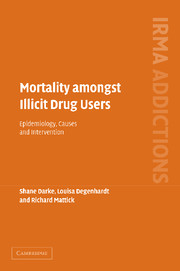Book contents
- Frontmatter
- Contents
- Acknowledgements
- List of tables
- Chapter 1 Why illicit drug-related deaths matter
- Chapter 2 The global epidemiology of illicit drug use
- Chapter 3 Mortality amongst illicit drug users
- Chapter 4 Mortality and drug overdose
- Chapter 5 Illicit drug use and disease
- Chapter 6 Mortality and suicide
- Chapter 7 Mortality and trauma
- Chapter 8 Reducing drug-related mortality
- Chapter 9 Summary and conclusions
- References
- Index
Chapter 8 - Reducing drug-related mortality
Published online by Cambridge University Press: 30 September 2009
- Frontmatter
- Contents
- Acknowledgements
- List of tables
- Chapter 1 Why illicit drug-related deaths matter
- Chapter 2 The global epidemiology of illicit drug use
- Chapter 3 Mortality amongst illicit drug users
- Chapter 4 Mortality and drug overdose
- Chapter 5 Illicit drug use and disease
- Chapter 6 Mortality and suicide
- Chapter 7 Mortality and trauma
- Chapter 8 Reducing drug-related mortality
- Chapter 9 Summary and conclusions
- References
- Index
Summary
Introduction
The preceding chapters have presented detailed analyses of the major causes of illicit drug-related mortality, as well as the demographic characteristics of drug-related fatalities, possible mechanisms, and risk factors for such deaths. In this chapter we examine various means of reducing such deaths. Some interventions are well established, such as the various treatment modalities for opioid dependence. Others have been proposed, but have yet to be implemented and/or evaluated. The area of drug-related traumatic injury has not been addressed at all by intervention, so any discussion is necessarily speculative.
Drug treatment
As noted in Chapter 3, drug-dependence treatment has a substantial role in reducing mortality and morbidity associated with illicit drug use. This is especially true in the context of opioid dependence, the drug class associated with the greatest risk of death (cf. Chapter 3). The strongest, and largest body, of research in this regard comes from studies of methadone-maintenance treatment (and other opioid replacement therapies), and its effect on drug-injecting behaviour and mortality rates. This is not, of course, to suggest that retention in other forms of long-term treatment, such as drug-free residential rehabilitation, do not reduce risk of death. Indeed, long-term retention in both maintenance and residential rehabilitation have been demonstrated to reduce the risk of non-fatal heroin overdose (Darke et al., 2005f; Stewart et al., 2002), and thus the risk of one of the major killers of opioid users.
- Type
- Chapter
- Information
- Mortality amongst Illicit Drug UsersEpidemiology, Causes and Intervention, pp. 111 - 134Publisher: Cambridge University PressPrint publication year: 2006

